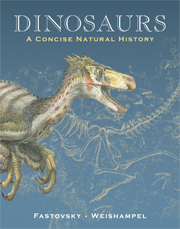Book contents
- Frontmatter
- Contents
- Why a natural history of dinosaurs?
- Dedication
- Part I Reaching back in time
- Part II Ornithischia: armored, horned, and duck-billed dinosaurs
- Part III Saurischia: meat, might, and magnitude
- 8 Sauropodomorpha: the big, the bizarre, and the majestic
- 9 Theropoda I: nature red in tooth and claw
- 10 Theropoda II: the origin of birds
- 11 Theropoda III: early birds
- Part IV Endothermy, endemism, and extinction
- Glossary
- Figure credits
- Index of subjects
- Index of genera
11 - Theropoda III: early birds
- Frontmatter
- Contents
- Why a natural history of dinosaurs?
- Dedication
- Part I Reaching back in time
- Part II Ornithischia: armored, horned, and duck-billed dinosaurs
- Part III Saurischia: meat, might, and magnitude
- 8 Sauropodomorpha: the big, the bizarre, and the majestic
- 9 Theropoda I: nature red in tooth and claw
- 10 Theropoda II: the origin of birds
- 11 Theropoda III: early birds
- Part IV Endothermy, endemism, and extinction
- Glossary
- Figure credits
- Index of subjects
- Index of genera
Summary
Chapter objectives
Learn about the evolutionary transition from Archaeopteryx to modern birds
Gain familiarity with the diversity of Mesozoic avian theropods
Mesozoic birds
Archaeopteryx, as we have seen, had many features that are far from the condition found in living birds, including teeth, an unfused hand, a bony tail, no synsacrum, and gastralia. How and when did the changes take place that distinguish living birds from Archaeopteryx? Here our interest will be within Avialae, the clade that includes Archaeopteryx, Aves (living birds), and everything in between.
The Mesozoic Avialary
Within Avialae, very close to Archaeopteryx is Rahonavis from the Late Cretaceous of Madagascar. We've opted to emphasize its avian features in tentatively considering it more derived than Archaeopteryx. Slightly larger than Archaeopteryx (the size of a crow; Figure 11.1), recent work places Rahonavis as a dromaeosaurid theropod, but its position above or below Archaeopteryx remains uncertain. It possessed an enlarged sickle-shaped claw on its feet (similar to that of dromaeosaurids and troodontids), and a long, Archaeopteryx-like tail. Younger that Archaeopteryx by 25 million years, it had forward-looking features such as pneumatic foramina leading into pleurocoels in its thoracic vertebrae, which as we've seen implies unidirectional breathing and possibly a more efficient metabolism (see Box 8.1 and Chapter 12), along with a series of other bird-like characters (Figure 11.2). Time and further analyses will eventually consolidate its position.
- Type
- Chapter
- Information
- DinosaursA Concise Natural History, pp. 235 - 245Publisher: Cambridge University PressPrint publication year: 2009

